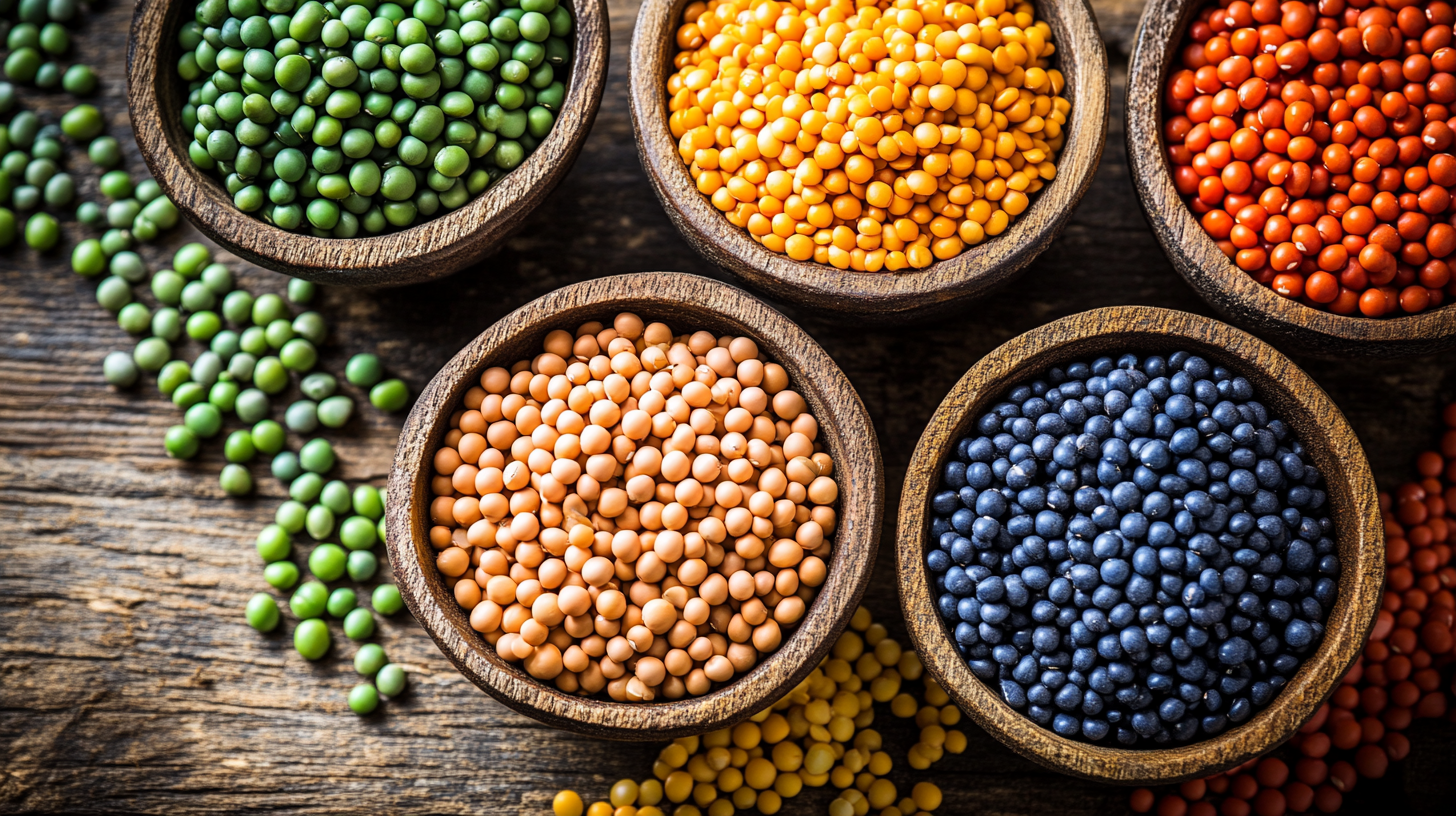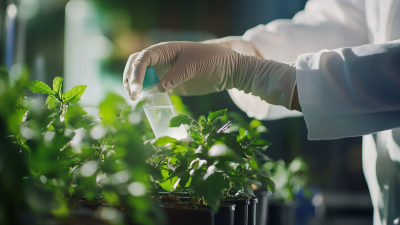 0551-68500918
0551-68500918 





Role of Innovative Fertilizers Chemicals in Sustainable Agriculture Development. Growing global food demand has increased the demand for solutions capable of improving crop yield and ensuring low environmental destruction. Modernizing Fertilizer Chemicals for unlocking agricultural potential ensures food security and links it with modern farm practices that have sustainability at their core. This blog will look at the innovative formulations and new processes that lay a foundation for success in global sourcing, so farmers and consumers benefit.
Innovation Meiland (Hefei) Co., LTD focuses strongly on the research and development of innovative pesticide products and their completely new formulations complementing the developments in fertilizer chemicals. The company is proudly headquartered in Hefei city of China with a mission-oriented commitment to designing solutions for agricultural efficiency and productivity through cutting-edge R amp; D. Helping build the future of agriculture with enabling tools to thrive in changing market scenarios is among our research objectives. This blog aims to focus on introducing the applications of these innovations and their importance to global agriculture, which is mainly contributed by fertilizer chemicals into achieving success.

Innovative fertilizers will advance sustainable agriculture with the advancement of the growing population, which is going to reach 9.7 billion people by 2050. The Food and Agriculture Organization revealed that 'food production should increase by 70% to feed this population. This means that traditional fertilizers, which typically do not supply adequate nutrients and, even worse, pollute the environment through runoff and greenhouse gas emissions, will not suffice for this." Innovative fertilizers include slow-release and controlled-release formulations to give sustainable alternatives. According to a report by the International Fertilizer Association (IFA), these new fertilizers will improve nutrient use efficiency as much as 30%. Further building on the use of bio-based fertilizers, which utilize natural materials to give important nutrients through reduced chemical inputs while at the same time improving soil health will increasingly gain popularity. These advanced fertilizers develop food productivity under agricultural practices; they also contribute to sustainable agriculture by minimizing environmental effects. The findings in the Journal of Cleaner Production reported that precision agriculture complements the new chemistries of fertilizers and enhances nitrogen fertilizer use efficiency by reducing it by about 20-25% and reducing greenhouse gas emissions. As more farmers and agribusinesses adopt sustainability as their focus in addressing issues, they are turning to innovative fertilizer chemicals at the forefront of agricultural success in a changing world.

In today's competition in agriculture, effective global sourcing strategies remain very crucial toward unleashing the innovative potential of fertilizer chemicals. The International Fertilizer Association states that the overall international market for fertilizers was about $200 billion in 2021 and is likely to cross about $300 billion by 2026. The growth certainly places increasing strategic sourcing importance to meet ever-rising demand for sustainable agricultural practices.
One of the effective approaches to global sourcing in agriculture is the usage of data analytics in the optimization of supply chains. A report by Mordor Intelligence asserts that data-driven decisions can lower costs of procurement by 10-20%. This is significant for fertilizers where procurement of quality raw material from different geographical sources optimizes efficacy but also takes down supply risks. For example, phosphate from Morocco or potash from Canada will have an effect on yield outcomes that assure the farmer of the best possible inputs regarding crops.
Collaboration between innovative fertilizer manufacturers and farmers allows them to access novel solutions such as slow-release or bio-based fertilizers. A recent market analysis from Research and Markets shows that biofertilizers are likely to grow at a compound annual growth rate of 13.8% from 2021 to 2026. By putting such products into their sourcing strategy, the agricultural businesses could, besides tapping into additional new markets, also become catalysts to environmental sustainability by combining economic and ecological needs in the new forms of farming practices.

In the recent past, agriculture has started to lean towards innovative fertilizer chemicals for maximizing efficiency and sustainability. The International Fertilizer Association mentions that global fertilizer consumption is expected to reach around 200 million metric tons by the year 2025 due to increasing food production requirements and soil fertility enhancement. This essentially implies that stakeholders involved in fertilizer sourcing must be cognizant of the newest trends in fertilizer chemicals.
Controlled-release fertilizers have emerged as one trend that witnesses increased adoption so that crops can receive precise nutrients over longer periods. The study conducted by the Journal of Agricultural Science states that CRFs increase nutrient use efficiency by around 30% as compared to conventional fertilizers; thus, they benefit higher crop yields while reducing environmental impact by minimizing nutrient runoff. With the move to sustainable practices adopted by farmers and agribusinesses, the demand for this fertilizer will see astronomical growth.
Biostimulants are also slowly gaining attention in the industry, and according to Grand View Research, this is a $3.3 billion market expected to grow at a rate of 10% per annum for the next five years. Such natural substances boost plant growth and health, therefore, being a supplement to conventional fertilizers. With increasing regulatory scrutiny of chemical inputs, biostimulants offer a greener alternative in line with the global trend towards sustainable agriculture. Growth of such innovation is both a means for companies to meet ever-changing market demands and would result in a more resilient agricultural ecosystem.

The rapid development of novel fertilizer-use chemicals is giving a huge uplift to agricultural practices and thereby improving yield and quality of crops. For sure, as further studies concern their impact, this very advancement serves chiefly to better soil health and nutrient availability. Therefore, the newer development activities in fertilizer technology focus on matching various crop and environmental needs to the sustainable means for optimizing farmers' outputs.
In the case of Beijing, modern agricultural production methods put stress on the overriding importance of these fertilizers. They not only assist in the amelioration of plant produce but also help in enhancing crops' nutritional quality, thereby impacting food security and public health. Fertilizers are now more intelligently designed as researchers and agriculturalists join hands, demonstrating increasing evidence that crops are growing stronger and are more resilient—an essential aspect in today's world dealing with challenges stemming from climate change.
In addition, global inputs into agricultural production would never hold on without innovative fertilizers. With advanced chemical fertilizers that meet particular crop needs, farmers will be able to operate more efficiently while at the same time working toward sustainability. This proves a great momentum toward integrated agricultural solutions promising large gains in productivity and profitability to map out a future for global agriculture.
Navigating the legal systems of new formulations of fertilizer chemicals is continued to open a future for agriculture on a national and international scale. The faster pace of innovation in fertilizer technology implies that businesses must dedicate human resources and finances into compliance obligations imposed by different nations with respect to the introduction and use of these products within that country. The laws vary country to country, ranging from general environmental safety requirements to product efficacy assessments, which are designed to create barriers within the global sourcing operations of a given company. And the other, understanding these regulations is primarily a function of legal compliance but also helps nurture trust and acceptance in the market.
To navigate these conditions successfully, one needs to engage and include collaboration with local regulators as well into this development process. This sort of engagement is very proactive toward identifying possible hindrances and product formulation agreement with local standards. Also, such partnerships can provide invaluable context and detail about needs from market and regulatory perspectives, because there are local agricultural bodies. Companies that take the time to invest in understanding these will find themselves much better positioned when it comes to the launch of new innovative solutions that meet compliance and agricultural demands.
Furthermore, the process of compliance is made smooth through applying technology. Digital facilities, as well as data analytics, can be used for monitoring changes in regulations and making way for documentation. Generally improves the entire process through these technological interventions. By going the technology way, companies would be assured of compliance but also in tune with the fast-evolving landscape of agriculture. While clearing these regulatory hurdles, fresh possibilities in the market are accessed and made tamper proof through new technologies for securing food supply via innovative fertilizer technology.
Looking at the fast-growing fertilizer industry, partnerships and working together are the major strategies to unleash agricultural potential and to assure success in global sourcing. The MarketsandMarkets report projects the global fertilizer market to reach USD 265.0 billion by 2025, growing at a CAGR of 3.2% from 2020. The fast growth indicates the need for all parties concerned-who are stakeholders ranging from manufacturing to distribution- to work collaboratively to meet the increasing demand for food production.
Such partnerships create synergies that simplify the supply chain and encourage innovation regarding fertilizer technologies. For example, through joint R&D, the creation of advanced fertilizers able to increase nutrient efficiency and lower environmental impacts was realized by agribusiness companies. The Fertilizer Institute said that partnerships improve nutrient use efficiency in crops by an average of 30%, thus increasing yield and minimizing wastage.
Companies can also gain local knowledge about soil health and crop needs through forming strategic partnerships with local farmers and agricultural organizations. Utilizing local wisdom and expertise would allow fertilizer firms to customize their products and services for more efficient fertilizer use. According to an FAO study, in targeted nutrient application based on local conditions, crop yields are increased by up to 50%; thus, the multi-benefit of collaboration.
Ultimately, the fertilizer industry-and agriculture in general-greatly learn from increased collaboration, and thus new partnerships arise to encourage innovation, enhance crop productivity, and improve worldwide sourcing systems. Although numerous stakeholders are involved, this collaboration can achieve phenomenal improvements in agricultural productivity, thus laying the foundations for a food-secure tomorrow.
In many countries worldwide, the introducing new types of fertilizers has triggered a revolution in agriculture and encouraged production yet again in providing the new heights within the field of sustainability or perhaps ecosystem services in the agriculture industry. Case studies carried out in different areas showcase the successful application of these state-of-the-art fertilizers in terms of significance to yield and environmental stewardship. For instance, the report released under the Food and Agriculture Organization (FAO) indicates that precision fertilizers can improve yield up to 30%, whilst also cutting nitrogen loss by as much as 25%.
In China, a new development was the practice of incorporating slow release fertilizers in rice. Farmers reportedly had 20% additional production, and this resulted in quite an adequate economic gain. Such fertilizers improved nutrient delivery and reduced adverse effects of conventional farming on soil health, according to a study published in the Journal of Agricultural Science.
Similarly, a project in Sub-Saharan Africa advocated the use of bio-based fertilizers, which gave phenomenal improvement in crop resilience, especially to maize farmers. This project as per the International Fertilizer Association (IFA) cost about 15% less in fertilizers, with increased harvest from crops by 40% after the interventions. Such case studies convey how the newly developed nitrogen fertilizer-producing technology increases the yield and remains able to develop sustainable agriculture across the globe.
Amid many other changes that are evolving, fertilizer chemicals are playing a vital role in transforming the landscape of agriculture. Innovative fertilizer solutions continue to emerge, especially because farmers are very much concerned with the effects of climate change. The present reality of degradation that is affecting the soil as well as fast-increasing global food demands can now be alleviated through these new improved fertilizer solutions; they are expected to contribute to the betterment of crop yields and proper management of sustainable agriculture. Therefore, advances in formulation and precision delivery systems signify that the future of fertilizers will not only be highly efficient but also very little environmental impact.
New technology has become the core feature of such change; Controlled-release fertilizers, for example, supply nutrients to the crop for a long period. It lessens the number of applications and runoffs of the nutrient to drainage waters. The use of microbial and biofertilizers in agriculture is gaining popularity in recent years; they invoke the natural processes in improving nutrient availability in the soil and also the soil health. These innovations will definitely increase the yield but, at the same time, will also harmonize agricultural practices with environment-friendly practices in food production.
The market will be molded into the future by fertilizers that will be effective but green in terms of production and use. Much of the collaboration among scientists, agronomists, and farmers will have to occur to develop desired solutions for specific crop requirements and region needs. Such efforts would strengthen the agricultural potential of the different regions of the world while forging new pathways to global food security. These new and innovative fertilizers will form the bedrock of modern agriculture.
Controlled-release fertilizers (CRFs) are designed to meet the precise nutrient needs of crops over extended periods, improving nutrient use efficiency by up to 30% compared to conventional fertilizers.
The demand for CRFs is rising due to farmers and agribusinesses’ efforts to adopt more sustainable practices that lead to higher crop yields and reduced environmental impact.
Biostimulants are natural substances that enhance plant growth and health, complementing traditional fertilizers and providing a greener alternative amid increasing regulatory scrutiny on chemical inputs.
The biostimulant market is projected to grow at a rate of 10% annually over the next five years, reaching $3.3 billion.
Innovative fertilizers lead to significant improvements in crop yields and quality by enhancing soil health and nutrient availability while ensuring sustainable agricultural practices.
Partnerships in the fertilizer industry help streamline supply chains, enhance innovation, and improve nutrient use efficiency, which can lead to significant increases in crop yields.
Collaborating with local farmers allows fertilizer companies to better understand regional soil health and crop needs, enabling them to tailor their products for more effective utilization.
Targeted nutrient application based on local conditions can increase crop yields by up to 50%, demonstrating the effectiveness of localized strategies.
Global fertilizer consumption is projected to reach approximately 200 million metric tons by 2025, driven by rising food production demands and needs for soil fertility enhancement.
Partnerships and collaborations foster innovation in fertilizer technologies and practices, leading to improved sustainability, productivity, and profitability in agricultural operations.





